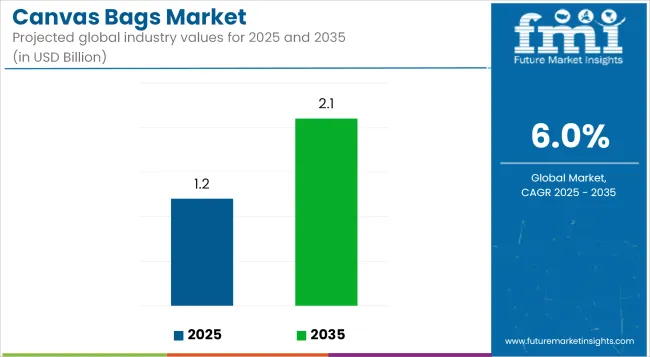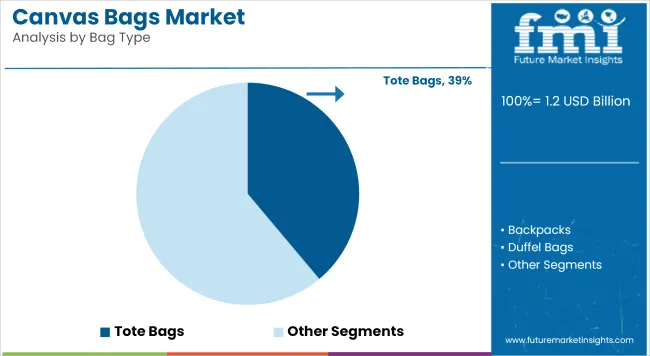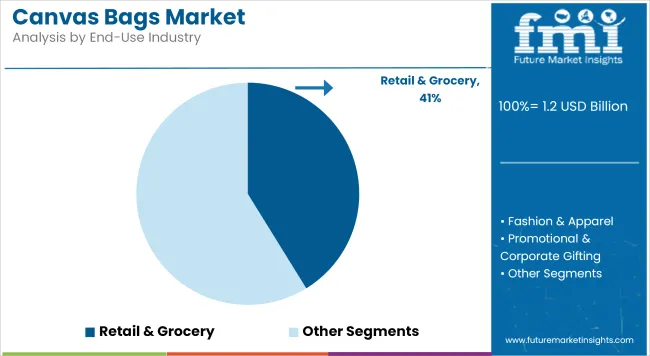The canvas bags is projected to grow from USD 1.2 billion in 2025 to USD 2.1 billion by 2035, registering a CAGR of 6.0% during the forecast period. Sales in 2024 reached USD 1.1 billion, Market growth is being supported by global restrictions on single-use plastic and heightened consumer demand for biodegradable and stylish carry solutions.

| Metric | Value |
|---|---|
| Market Size in 2025 | USD 1.2 Billion |
| Projected Market Size in 2035 | USD 2.1 Billion |
| CAGR (2025 to 2035) | 6.0% |
Canvas bags are being widely adopted by retailers, grocery chains, and lifestyle brands as a durable and reusable alternative to plastic. Market penetration is being driven by both environmental regulations and increased urban use in North America, Europe, and Asia-Pacific. Retail branding applications have also played a pivotal role in adoption. As eco-conscious purchasing behavior becomes mainstream, demand for canvas alternatives is expected to strengthen considerably over the decade.
The market has been positively impacted by innovations in printing technologies and the adoption of organically sourced cotton and jute materials. Water-based inks, natural dyes, and reduced stitching waste are being incorporated into production processes. Brands have begun offering custom-sized canvas bags optimized for promotional and commercial use, leveraging eco-certification as a value proposition.
Printing advancements, including digital and silk screen techniques, have enabled greater product variety. Reusability and wash ability are improving lifecycle economics, contributing to retail uptake. Moreover, sustainability certifications such as GOTS and OEKO-TEX have started influencing procurement decisions, especially for European buyers. These developments underscore the transition of canvas bags from a basic utility item to a sustainable branding tool.
The market is likely to witness heightened consolidation around ethical sourcing and low-carbon manufacturing practices. Localized production hubs are expected to strengthen in Asia-Pacific and Latin America, supporting logistics and reducing import dependencies. As climate commitments intensify, government-backed programs favoring fabric-based alternatives could further stimulate market expansion.
Meanwhile, canvas bags with added features such as foldability, zipper compartments, and reinforced bases are forecast to gain traction in travel, education, and food delivery sectors. Private labels and DTC brands are anticipated to focus on seasonal releases and themed collections to create differentiation. As regulatory enforcement of plastic bans widens, revenue potential in the canvas segment is projected to grow substantially across both urban and semi-urban consumption zones.
The market is segmented based on bag type, material type, closure type, end-use industry, and region. Bag types include tote bags, drawstring bags, backpacks, messenger bags, duffel bags, grocery bags, and handbags & pouches-each tailored for varied consumer and commercial utility, from daily use to specialized functions. Material types cover standard cotton canvas, organic cotton canvas, recycled cotton canvas, blended canvas (cotton-polyester), and dyed/printed canvas-chosen for their durability, eco-friendliness, and aesthetic appeal.
Closure types include open top, zipper closure, button & loop closure, Velcro closure, and drawstring closure-each offering differing levels of accessibility and security. End-use industries encompass retail & grocery, fashion & apparel, promotional & corporate gifting, food & beverage packaging, personal use & travel, and institutional & educational. Regional segmentation includes North America, Latin America, East Asia, South Asia & Pacific, Eastern Europe, Western Europe, Oceania, and Middle East & Africa.
Tote bags are expected to account for 38.9% of the canvas bags market by 2025. Their spacious, open-top design and dual-handle format have made them popular for both everyday use and commercial applications. These have been widely adopted for promotional campaigns due to their large printable surface. Growing environmental awareness has supported their use as eco-friendly retail alternatives to plastic.
Tote bags have been manufactured using 100% cotton, organic blends, and recycled canvas fibers. Their durability and reusability have led to widespread usage in supermarkets, bookstores, and fashion outlets. Customization in terms of color, printing, and logo placement has allowed companies to use them as walking advertisements. Demand has risen due to consumer preference for aesthetic and practical packaging solutions.
Brands have integrated gussets, internal pockets, and reinforced handles to cater to retail and gifting purposes. These features have enhanced their appeal for daily commuting, shopping, and light travel needs. Their compatibility with sustainable branding goals has increased bulk procurement by event organizers and retailers. Many enterprises have chosen them as part of CSR-driven gifting programs.
Global tote bag suppliers have focused on lightweight variants for mass retail and thicker canvas for premium branding. Machine wash ability, longevity, and biodegradability have become critical selling points. Production has also shifted toward ethical sourcing and fair trade-certified textiles. These factors have positioned tote bags as the preferred category within canvas-based carrying solutions.

Retail & grocery stores are projected to hold a leading market share of 41.2% in the end-use segment by 2025. These outlets have widely adopted canvas bags as durable alternatives to single-use plastic carry bags. Growing regulatory restrictions and green consumerism have boosted demand across supermarkets, organic stores, and general retail chains.
Custom branding and repeat use have reinforced their popularity. Reusable canvas bags have been distributed as part of loyalty programs and checkout counter sales. Supermarkets have stocked them as both primary shopping carriers and impulse-purchase lifestyle products. Their robustness, ease of folding, and visual appeal have contributed to consistent customer reuse. Private label programs have increasingly incorporated canvas tote options as value-added products.
Retailers have integrated sustainability goals by offering canvas bags made from organic cotton and recycled yarns. Many brands have promoted “bring your own bag” initiatives to reduce in-store packaging waste. Campaigns highlighting the environmental footprint of plastic have supported sales of eco-friendly canvas variants. Major grocery chains have offered incentives for using such alternatives.
Bulk purchasing by retail chains has encouraged standardized sizing, printing, and display packaging for canvas bags. This has lowered unit costs and enabled wider reach in developing and developed markets. Retail-driven demand is expected to expand further with legislative bans on plastics in emerging economies. Canvas bags have thus become a symbol of both utility and environmental consciousness in retail sectors.

Price Sensitivity and Substitute Competition
Price sensitivity is the biggest challenge of the canvas bags industry. Canvas bags are more expensive than plastic or man-made bags, and price-sensitive consumers may turn away from them because of this aspect. Also, other eco-friendly materials such as jute, hemp, or recycled plastic are increasingly becoming popular, and consumers are being offered more choice as green consumers.
With the larger quantity of options becoming more accessible, this presents even more competition for canvas bags. The companies have to keep introducing quality and long-lasting bags at a competitive price to keep competing. Promoting the long-term value and environmentally friendly nature of canvas bags will also encourage customer demand.
Growing Demand for Sustainable and Customized Products
No matter what the scenario is in the market, there are sufficient opportunities present in the increasing demand for green and personalized products. Nowadays, people seek products more and more through which they can express something about their own individuality and green consciousness. Placing personalized canvas bags with personalized features like exclusive designs or prints can bring huge value to their attraction.
Such practices as the use of natural material, ethical labour practices, and eco-friendly production processes can appeal to nature-aware consumers. This customization and sustainable fashion trend guarantees new differentiation for the canvas bag highly competitive market.
The American market for canvas totes has expanded, buoyed by the heightened green sensitivity and state legislatures banning plastic bags. Discount powerhouse Trader Joe's brought canvas totes mainstream. Partnerships with green nonprofits by fashion designers constitute another mechanism of popularity that brings canvas totes to light as a pairing of style with eco-friendliness.
| Country | CAGR (2025 to 2035) |
|---|---|
| USA | 5.5% |
Canvas bags are the standard in the UK as the government initiated the plastic bag tax in 2015. Fashion-conscious retailers such as Marks & Spencer instituted "Bag for Life" policies, issuing long-lasting canvas bags to be used repeatedly. Cultural transformation to embrace sustainability has guaranteed that canvas bags are fashionable and practical.
| Country | CAGR (2025 to 2035) |
|---|---|
| UK | 5.2% |
The EU's robust environmental regulations have ensured single-use plastics are controlled, and canvas bag production has thus become more common. Local designers as well as large-scale brands have come up with various canvas bag varieties in Germany and France. Instances like the EU's Circular Economy Action Plan are ensuring greener product markets like canvas bags continue to grow.
| Country/Region | CAGR (2025 to 2035) |
|---|---|
| EU | 5.3% |
Japan's simple culture and nature-focused culture are precisely what is reflected in the usage of canvas bags. Muji and other corporations have adopted plain, no-frills designs, and consumers now have a significant preference for canvas bags. Sanctioned anti-waste campaigns also encourage the practice.
| Country | CAGR (2025 to 2035) |
|---|---|
| Japan | 5.8% |
South Korea's canvas bag market has expanded, spurred by global fame of K-fashion and local consumption of greenness. Canvas bags cover celebrities and influencers, uniting fashion and nature. Policies by the government to eradicate plastic waste have stimulated this market.
| Country | CAGR (2025 to 2035) |
|---|---|
| South Korea | 5.1% |
The market for canvas bags is expanding at a rapid pace because of increased environmental awareness and the transition toward environmentally friendly consumer products. Multifunctional use of canvas bags in various applications and eco-friendliness are the reasons they have become the top choice among various consumer segments.
Governments and institutions worldwide are embracing policies and legislations to govern the utilization of plastic, hence propelling the utilization of canvas bags. For instance, single-use plastic bags are banned or taxed in the majority of countries, and retailers and customers have been compelled to embrace green substitutes. The consequence of such a policy environment is a welcoming market for canvas bags because they are compliant with policy demands to avoid wastage of plastics.
The adoption by the fashion industry of canvas bags to break into the mainstream fashion has also contributed to market expansion, focusing on style-conscious consumers. Designers and companies now increasingly produce canvas bags in styles, designs, and colors, thereby selling them as fashion accessories. The merging of green and fashion has brought a new element to canvas bags, focusing on consumers who look for beauty as well as a green agenda.
Technological innovation in manufacturing industry brought low-cost quality canvas bags, hence reaching more customers. Technological innovation in printing and textile processing brought personalized durable products by simplified manufacturing. Economies of scale with higher output levels brought the cost of production to a greater market base even lower.
The collective effect of product multi-functionality required by consumers, sustainability trends, and policy support will continue to be an important driver in market expansion of canvas bags. As long as environmental concerns are at the top of the agenda for countries, the market for environmentally sustainable and functional products will grow even larger. Firms whose plan is to catch up with such trends will be compelled to take the extra opportunities in the market, thus opening up the path to a green future.
The world market for canvas bags is witnessing rapid growth as a result of rising green awareness and the green movement towards green products. Demand for environment-friendly and reusable products to substitute plastic disposable bags is driving demand for canvas bags at a faster rate. The trend is also being driven by the shift in governments towards banning plastic bags and adopting sustainable development.
The overall market size for the canvas bags market was USD 1.2 billion in 2025.
The canvas bags market is expected to reach USD 2.1 billion by 2035.
The demand for the canvas bags market will be driven by increasing environmental consciousness, government initiatives promoting eco-friendly products, rising disposable incomes, the fashion industry's shift towards sustainable materials, and consumer preference for durable and reusable bags.
The top 5 countries driving the development of the canvas bags market are the United States, China, India, Germany, and the United Kingdom.
The canvas tote bag segment is expected to command a significant share over the assessment period.






Full Research Suite comprises of:
Market outlook & trends analysis
Interviews & case studies
Strategic recommendations
Vendor profiles & capabilities analysis
5-year forecasts
8 regions and 60+ country-level data splits
Market segment data splits
12 months of continuous data updates
DELIVERED AS:
PDF EXCEL ONLINE
Canvas and Muslin Bags Market Size, Share & Forecast 2025 to 2035
Leading Providers & Market Share in Canvas and Muslin Bags
Canvas Roll Market Size and Share Forecast Outlook 2025 to 2035
Canvas Primer Market Analysis - Growth, Demand & Trends 2025 to 2035
Polybags Market Size and Share Forecast Outlook 2025 to 2035
Net Bags Market
VCI Bags Market
Sandbags Market
Leno Bags Market Size and Share Forecast Outlook 2025 to 2035
Silo bags Market Size and Share Forecast Outlook 2025 to 2035
Food Bags Market Share, Size, and Trend Analysis for 2025 to 2035
Competitive Breakdown of Silo Bag Manufacturers
Paper Bags Market Size and Share Forecast Outlook 2025 to 2035
Jumbo Bags Market Size and Share Forecast Outlook 2025 to 2035
Blood Bags Market Size and Share Forecast Outlook 2025 to 2035
Craft Bags Market Growth, Trends, Forecast 2025 to 2035
Market Share Breakdown of Craft Bags Manufacturers
Competitive Breakdown of Paper Bags Providers
Market Share Analysis of Jumbo Bags & Key Players
Grout Bags Market Demand & Construction Industry Trends 2024 to 2034

Thank you!
You will receive an email from our Business Development Manager. Please be sure to check your SPAM/JUNK folder too.
Chat With
MaRIA